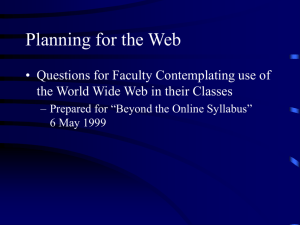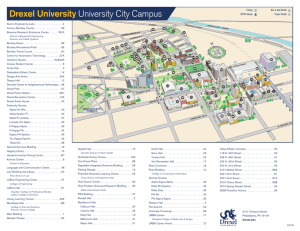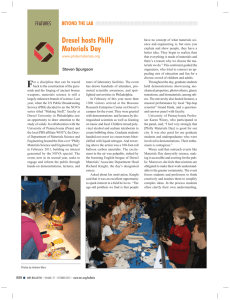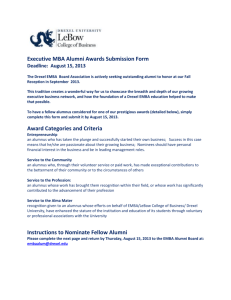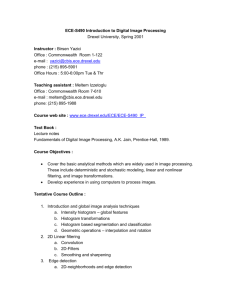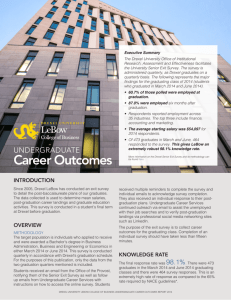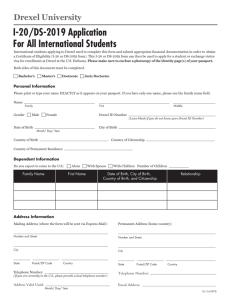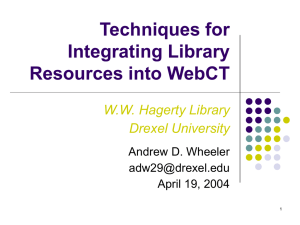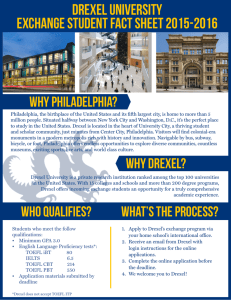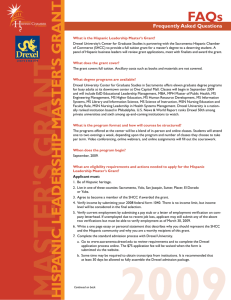Page 1 of 9 Setting Expectations The differences between traditional
advertisement
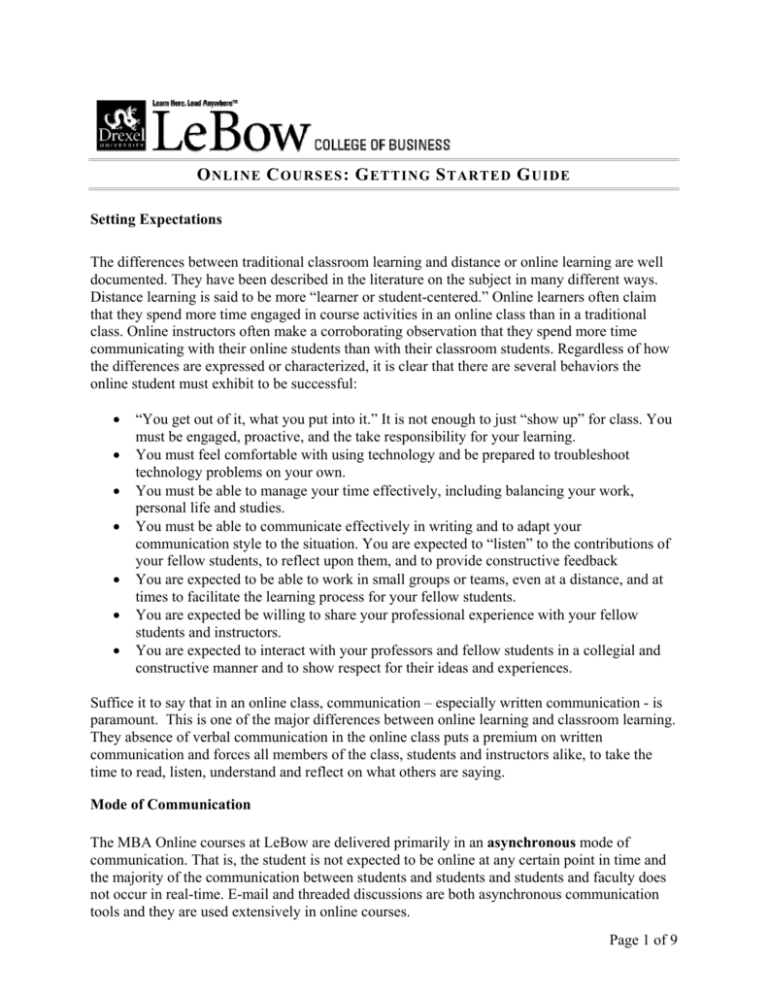
O NLINE C OURSES : G ETTING S TARTED G UIDE Setting Expectations The differences between traditional classroom learning and distance or online learning are well documented. They have been described in the literature on the subject in many different ways. Distance learning is said to be more “learner or student-centered.” Online learners often claim that they spend more time engaged in course activities in an online class than in a traditional class. Online instructors often make a corroborating observation that they spend more time communicating with their online students than with their classroom students. Regardless of how the differences are expressed or characterized, it is clear that there are several behaviors the online student must exhibit to be successful: • • • • • • • “You get out of it, what you put into it.” It is not enough to just “show up” for class. You must be engaged, proactive, and the take responsibility for your learning. You must feel comfortable with using technology and be prepared to troubleshoot technology problems on your own. You must be able to manage your time effectively, including balancing your work, personal life and studies. You must be able to communicate effectively in writing and to adapt your communication style to the situation. You are expected to “listen” to the contributions of your fellow students, to reflect upon them, and to provide constructive feedback You are expected to be able to work in small groups or teams, even at a distance, and at times to facilitate the learning process for your fellow students. You are expected be willing to share your professional experience with your fellow students and instructors. You are expected to interact with your professors and fellow students in a collegial and constructive manner and to show respect for their ideas and experiences. Suffice it to say that in an online class, communication – especially written communication - is paramount. This is one of the major differences between online learning and classroom learning. They absence of verbal communication in the online class puts a premium on written communication and forces all members of the class, students and instructors alike, to take the time to read, listen, understand and reflect on what others are saying. Mode of Communication The MBA Online courses at LeBow are delivered primarily in an asynchronous mode of communication. That is, the student is not expected to be online at any certain point in time and the majority of the communication between students and students and students and faculty does not occur in real-time. E-mail and threaded discussions are both asynchronous communication tools and they are used extensively in online courses. Page 1 of 9 Courses do however follow the schedule of the regular academic term. Students are expected to complete assignments and engage in other instructional activities by certain deadlines, as prescribed in a course syllabus. Recognizing that the main benefit to students of online learning is the convenience and flexibility it affords, MBA Online courses strive to achieve a balance between providing such convenience and providing quality, valuable, and rigorous business education and training. Depending upon the objectives of a course and the needs of the students in the course, some faculty may decide to plan educational activities that require real-time or synchronous communication. If such activities are graded components, faculty are required to provide students with different scheduling options to participate in them. This maintains a degree of convenience and flexibility, while allowing for the benefits of real-time communication. Chat, teleconference, and virtual classrooms are synchronous communications tools used in online courses. Frequently Asked Questions 1. How do I access my online courses? • • Visit: http://learning.drexel.edu Enter your Drexel User ID and Password into the appropriate fields in the login form. 2. When do online courses begin? Online courses follow the same schedule as on-campus courses. To learn specific dates per term, visit www.drexel.edu/SRC and follow the links for “Current Students” and “Academic Calendars.” In general, every effort is made to open online courses prior to the beginning of the academic term, so students have some lead time to obtain required course materials, such as text books. However, there are times when courses are under development right up to the beginning of the term and therefore they may not be accessible prior to the first day of classes. The MBA Online Programs office regulates course registration. As a matter of routine, the office will advise you by e-mail once you are registered for a course. 3. Where do I go for technical support? Support for your online courses is available from: • LeBow’s technical support team at intech@lebow.drexel.edu. • Drexel University’s IRT department at olt@drexel.edu In addition, Drexel University’s IRT department has developed a Bb Vista trouble shooting guide. To access the guide, visit www.drexel.edu/irt/services/webct Page 2 of 9 4. What kinds of software/hardware do I need in addition to a Web browser and the basic technical requirements for gaining access to the online campus? The MBA Online campus is powered by a platform provided by Bb Vista. In general, the Bb Vista software is designed to work with recent versions of popular Web browsers and popular operating systems. Acceptable browsers include: • Microsoft IE 6SP1, 6 SP2 7 • Netscape 7.2 • AOL 9 • Mozilla 1.7 • Firefox 1.0.x, 1.5.x, 20 Acceptable operating systems include: Windows 98 - A personal computer with a 486DX 66 megahertz (MHz) or faster processor (Pentium central processing unit recommended). - 16 megabytes (MB) of memory (24 MB recommended). - A typical upgrade from Windows 95 requires approximately 195 MB of free hard disk space, but the hard disk space may range between 120 MB and 295 MB, depending on your computer configuration and the options that you choose to install. Windows Me - Pentium 150-MHz processor or better - 32 megabytes (MB) of RAM or better - Minimum 320 MB of free hard-disk space Windows 2000 - 133 MHz or higher Pentium-compatible CPU - 64 megabytes (MB) of RAM recommended minimum - 2GB hard disk with a minimum of 650MB of free space. Windows XP - Pentium 233-megahertz (MHz) processor or faster (300 MHz is recommended) - At least 64 megabytes (MB) of RAM (128 MB is recommended) - At least 1.5 gigabytes (GB) of available space on the hard disk Mac® OS 9.x - At least 32 MB of RAM with virtual memory set to 64 MB - 320 MB of available hard disk space - Power Mac G4 or Macintosh Server G4 (all models) - Power Macintosh G3 or Macintosh Server G3 (all models) - iMac (all models) Page 3 of 9 - iBook (all models) - PowerBook (all models later than the original PowerBook G3) OS 10.1.x Mac OS X requires a minimum of 128MB of memory and is designed to run on the following Apple products: iMac®, iBook, Power Macintosh® G3, Power Mac™ G4, Power Mac G4 Cube and any PowerBook introduced after May 1998. The software needs of courses can vary. If a course requires specific software that is not among the standard office productivity tools or the standard Web browsing tools, this will be specified in the course syllabus or through communication from your professor. Software: • MS Office Suite • Anti-Virus Software (e.g. Norton Anti-virus) • Real Network’s RealPlayer • Windows Media Player • Adobe Acrobat Reader • Macromedia Flash Player • JavaScript and Java enabled browser (current browser versions are equipped with these, but there may be times when you have to configure the browser’s settings for them to work properly.) The following are hardware components that are commonly used: • • • • • Sound card Speakers 56K Modem for dialup connections Network interface card for DSL or Cable modem connections Printer Please Note We cannot guarantee accessibility to all aspects of the online courses if you are behind a corporate firewall. It is solely the student’s responsibility to arrange access prior to class. LeBow College of Business is not responsible for attaining access to the courses. 5. What about books? Do courses use text books? How do I obtain them? Yes, even though these are online courses, professors still rely on text books and other printed materials. You can purchase the text books required for your courses from a retailer of your choice. Page 4 of 9 Every effort is made to provide students with enough lead time to obtain required text books in advance of the beginning of the academic term. However, due to the way in which academic departments work with publishers to adopt texts, there are times when the required book information is not available until the just prior to the beginning of the course. In addition to text books, some professors will compile a number of works from periodicals and the popular press for course readings. In these cases, every effort is made to distribute the materials online through the respective courses in which they are used. Navigating through Bb Vista Step 1: Disabling Pop Ups • In the Safari browser, use the Command+k key combo to toggle the pop-up blocker on or off. • In Firefox, OS X users should add the URL, http://learning.dcollege.net, for their WebCT entry page to the list of allowed sites. You can do that by selecting Preferences in the Firefox menu, selecting the Content tab, selecting the Allowed Sites button and pasting in the URL of the course entry page. • In Internet Explorer, select Tools > Pop up Blocker > Pop Up Blocker Settings. Add the URL, http://learning.dcollege.net, to Address of Web site to allow section. • Pop-up blocking functions are included in some anti-virus, internet security, personal firewall, and browser programs. Disable the relevant setting in the program or set your WebCT server as an allowed site. Step 2: Login • • • To access your online courses in Bb Vista, visit the following link: http://learning.dcollege.net You may also use DrexelOne to access courses. You must run a Browser Check. o Be sure your Java is up to date (www.java.com) o Be sure your pop up settings are correct Page 5 of 9 The login page can be accessed via http://learning.dcollege.net Step 3: Navigation Once you login to Bb Vista you will be presented with your main course page. From here, you will click on the link corresponding to the course you wish to access. On each course homepage you will see Instructor information, a course contents folder, and folders designating each week of the course. Tools are available on the left hand side of the page. It is important to note that not all courses utilize all the tools. By clicking the Course Content button at the top, you can also display a navigational course menu. Page 6 of 9 By clicking “Course Contents,” you can see a navigational display of the course. My Settings The system allows you to customize the way you view and interact with Bb Vista. To edit the settings do the following: 1. Click My Settings in the upper right hand corner of your Course List 2. The My Settings section has three tabs: My Profile, My Tool Options and My Roles My Profile This section displays your username, first and last names, email and a picture. You can edit the photo of yourself and change your email address. You can also choose to make this information public or private. Please note, if you change your email address, you will still be responsible for checking your Drexel University email account. My Tool Options The My Tool Options allows you to determine how you interact with some of the tools. Page 7 of 9 Calendar You can choose how you want the calendar displayed and on what day the week begins. Discussions You can choose whether to have your own posts viewable as read, to view the discussions in a threaded or unthreaded format, the position of the new threads and what messages to display. Fonts You can determine the font size and type in one location. This will affect the font in each class. Page 8 of 9 Email If you would like the emails to be forwarded from BB Vista to your email account, select Mail Forwarding. This will affect your email in each class. Page 9 of 9
